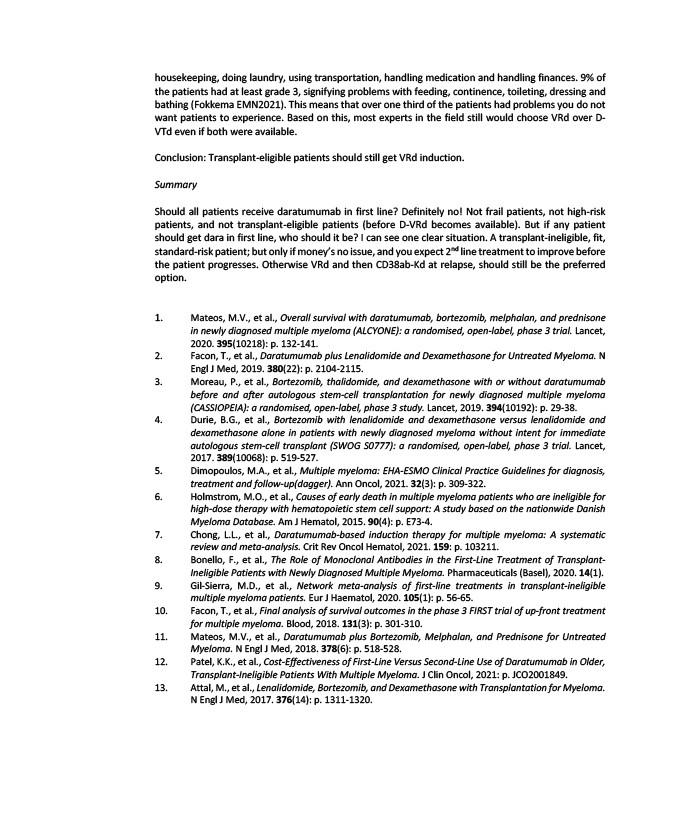
housekeeping, doing laundry, using transportation, handling medication and handling finances. 9% of
the patients had at least grade 3, signifying problems with feeding, continence, toileting, dressing and
bathing (Fokkema EMN2021). This means that over one third of the patients had problems you do not
want patients to experience. Based on this, most experts in the field still would choose VRd over D-VTd
even if both were available.
Conclusion: Transplant-eligible patients should still get VRd induction.
Summary
Should all patients receive daratumumab in first line? Definitely no! Not frail patients, not high-risk
patients, and not transplant-eligible patients (before D-VRd becomes available). But if any patient
should get dara in first line, who should it be? I can see one clear situation. A transplant-ineligible, fit,
standard-risk patient; but only if money’s no issue, and you expect 2nd line treatment to improve before
the patient progresses. Otherwise VRd and then CD38ab-Kd at relapse, should still be the preferred
option.
1. Mateos, M.V., et al., Overall survival with daratumumab, bortezomib, melphalan, and prednisone
in newly diagnosed multiple myeloma (ALCYONE): a randomised, open-label, phase 3 trial. Lancet,
2020. 395(10218): p. 132-141.
2. Facon, T., et al., Daratumumab plus Lenalidomide and Dexamethasone for Untreated Myeloma. N
Engl J Med, 2019. 380(22): p. 2104-2115.
3. Moreau, P., et al., Bortezomib, thalidomide, and dexamethasone with or without daratumumab
before and after autologous stem-cell transplantation for newly diagnosed multiple myeloma
(CASSIOPEIA): a randomised, open-label, phase 3 study. Lancet, 2019. 394(10192): p. 29-38.
4. Durie, B.G., et al., Bortezomib with lenalidomide and dexamethasone versus lenalidomide and
dexamethasone alone in patients with newly diagnosed myeloma without intent for immediate
autologous stem-cell transplant (SWOG S0777): a randomised, open-label, phase 3 trial. Lancet,
2017. 389(10068): p. 519-527.
5. Dimopoulos, M.A., et al., Multiple myeloma: EHA-ESMO Clinical Practice Guidelines for diagnosis,
treatment and follow-up(dagger). Ann Oncol, 2021. 32(3): p. 309-322.
6. Holmstrom, M.O., et al., Causes of early death in multiple myeloma patients who are ineligible for
high-dose therapy with hematopoietic stem cell support: A study based on the nationwide Danish
Myeloma Database. Am J Hematol, 2015. 90(4): p. E73-4.
7. Chong, L.L., et al., Daratumumab-based induction therapy for multiple myeloma: A systematic
review and meta-analysis. Crit Rev Oncol Hematol, 2021. 159: p. 103211.
8. Bonello, F., et al., The Role of Monoclonal Antibodies in the First-Line Treatment of Transplant-
Ineligible Patients with Newly Diagnosed Multiple Myeloma. Pharmaceuticals (Basel), 2020. 14(1).
9. Gil-Sierra, M.D., et al., Network meta-analysis of first-line treatments in transplant-ineligible
multiple myeloma patients. Eur J Haematol, 2020. 105(1): p. 56-65.
10. Facon, T., et al., Final analysis of survival outcomes in the phase 3 FIRST trial of up-front treatment
for multiple myeloma. Blood, 2018. 131(3): p. 301-310.
11. Mateos, M.V., et al., Daratumumab plus Bortezomib, Melphalan, and Prednisone for Untreated
Myeloma. N Engl J Med, 2018. 378(6): p. 518-528.
12. Patel, K.K., et al., Cost-Effectiveness of First-Line Versus Second-Line Use of Daratumumab in Older,
Transplant-Ineligible Patients With Multiple Myeloma. J Clin Oncol, 2021: p. JCO2001849.
13. Attal, M., et al., Lenalidomide, Bortezomib, and Dexamethasone with Transplantation for Myeloma.
N Engl J Med, 2017. 376(14): p. 1311-1320.